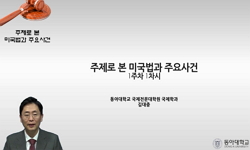우리나라의 사법행정제도는 대법원장과 법원행정처를 중심으로 하는 수직적, 중앙집중적, 폐쇄적 구조를 가지고 있었고, 이러한 구조의 문제점은 2017년을 기점으로 극명하게 드러났다. 이...
http://chineseinput.net/에서 pinyin(병음)방식으로 중국어를 변환할 수 있습니다.
변환된 중국어를 복사하여 사용하시면 됩니다.
- 中文 을 입력하시려면 zhongwen을 입력하시고 space를누르시면됩니다.
- 北京 을 입력하시려면 beijing을 입력하시고 space를 누르시면 됩니다.
부가정보
국문 초록 (Abstract)
우리나라의 사법행정제도는 대법원장과 법원행정처를 중심으로 하는 수직적, 중앙집중적, 폐쇄적 구조를 가지고 있었고, 이러한 구조의 문제점은 2017년을 기점으로 극명하게 드러났다. 이러한 배경 속에서 재판의 독립을 위협할 수 있는 제도적 요소들을 변화시키기 위한 움직임이 진행되었고, 법원에서는 전국법관대표회의, 국민과 함께하는 사법발전위원회를 중심으로 사법행정제도의 개혁이 활발하게 논의되었다.
의사결정, 집행, 연구 기능이 결합된 법원행정처를 의사결정 중심의 수평적 회의체, 집행 중심의 법원사무처, 연구 중심의 사법정책연구원 및 사법연수원으로 기능적, 조직적으로 분리하는 것이 하나의 대안이 되었고, 사법행정절차를 투명하게 진행하는 것, 사법행정에 법원 외부의 인사가 참여하여 견제와 균형이 이루어질 수 있도록 하는 것 등이 중요한 과제로 인식되었다. 또한 각급 법원에서도 수직적인 사법행정을 개혁하고자 하였다.
이러한 기본적인 방향을 수평화, 분권화, 개방화라고 말할 수 있는데, 법원의 자체 개혁을 통해 여러 구상들이 실제로 제도화되기도 하였으나, 대법원의 내부 규칙 등에 의존한 것으로서 아직 제도가 완비되었다고 볼 수는 없다. 입법을 통한 제도화도 사실상 중단된 상태이다. 이에 사법의 독립을 침해하지 않으면서 중립적이고 공정한 재판을 보장할 수 있는 사법행정구조를 형성하기 위해 남겨진 과제들을 적극적으로 모색하여야 한다.
다국어 초록 (Multilingual Abstract)
The judicial administration system of Korea was based on a vertical, centralized, and closed structure centering around the Chief Justice and National Court Administration, and such structural problems were starkly brought to light in 2017. Since then...
The judicial administration system of Korea was based on a vertical, centralized, and closed structure centering around the Chief Justice and National Court Administration, and such structural problems were starkly brought to light in 2017.
Since then, the movement towards reform of the judicial administration system jeopardizing the independence of judges and trials has been made while the measures to reform the judicial administration, on the basis of the National Conference of Judiciary Representatives and the Committee on Judicial System Development involving citizens, have been under active discussion in the court.
A functional, structural division of the National Court Administration serving multiple functions of decision-making, execution, and research into a horizontal meeting group mainly responsible for decision-making, the Administrative Office of the Courts for execution, and the Judicial Policy Research Institute and Training Institute for Court Officials for research has been agreed as an effective alternative. In addition, achieving greater transparency for judicial administration procedures and strengthening checks and balances by appointing outsiders for judicial administration have been pointed out as major tasks. The courts of each level have also endeavored to reform the judicial administration system through measures such as the Judge Conference.
Such internal reform efforts, made in the fundamental direction of horizontality, decentralization, and openness, have come into fruition as a number of the reform proposals have been institutionalized. However, the institutionalization has its limitations due to its dependency on the internal rules set out by the Supreme Court.
The reform of the judicial administration system, therefore, should be brought to completion in tandem with legislation for the fulfillment of the core judicial values of independce, impartiality, and fairness.
동일학술지(권/호) 다른 논문
-
불법목적의 회사설립과 공전자기록 등 불실기재죄 - 대법원 2020. 2. 27. 선고 2019도9293 판결 -
- 법조협회
- 孟峻永 ( Maeng Joon Young )
- 2023
- KCI우수등재
-
직무발명제도 개선을 위한 발명진흥법 제15조 제6항 단서의 해석 및 개정 방향
- 법조협회
- 윤선희
- 2023
- KCI우수등재
-
상속개시 전 증여재산이 처분된 경우와 유류분 산정시 증여재산의 가액산정 시점 - 대법원 2023. 5. 18. 선고 2019다222867 판결의 검토 -
- 법조협회
- 이승현
- 2023
- KCI우수등재
-
소수지분권자의 위법한 공유물 점유에 관한 판결 유감(遺憾) - 대법원 2020. 9. 7. 선고 2017다204810 판결의 소개 -
- 법조협회
- 박봉철
- 2023
- KCI우수등재





 KCI
KCI KISS
KISS





